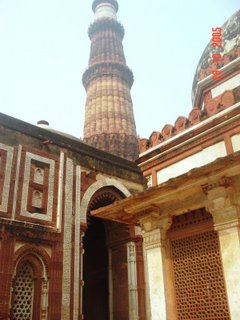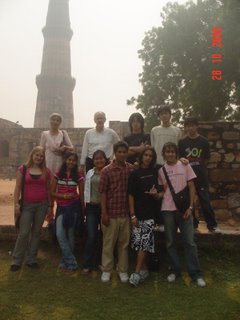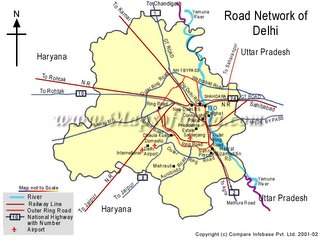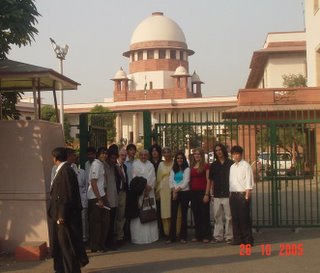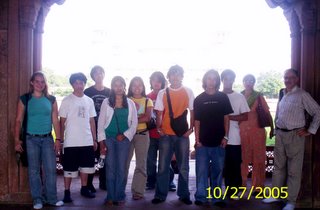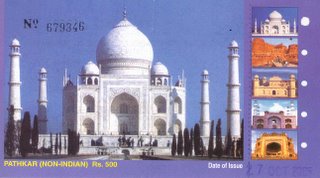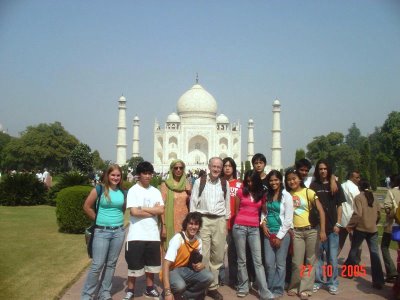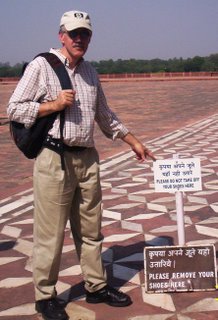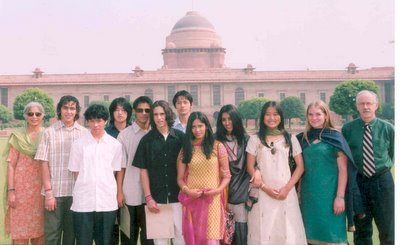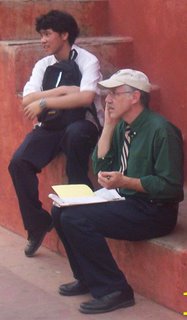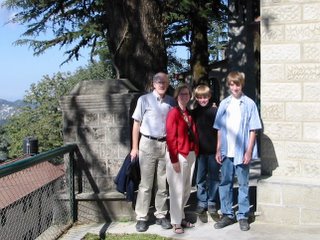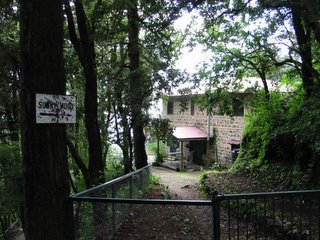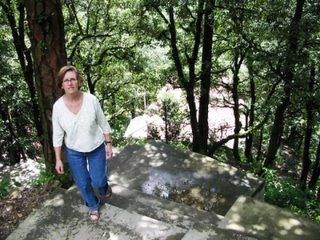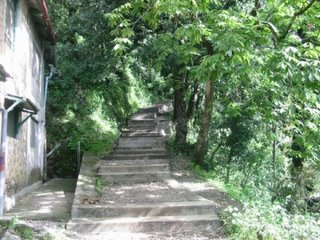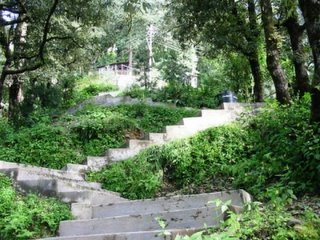Notes on Driving in India
Notes on Driving, made after our long drives from Woodstock to Delhi and Agra, and back:
Along the road north of Delhi are a number of hand-operated large tricycles, evidently for paraplegics – moving along the roadway along with countless bicycles and oxcarts heavily laden with incredible loads of bricks or subgarcane. This is especially dangerous at night, because very few of these vehicles have any tail-lights or reflectors.
Trucks traditionally have gaudy English inscriptions on the back: “Keep Distance” “Blow Horn” “Use Dipper At Night”, and patriotic Hindi inscriptions “Jai Hind” on the side, with a flag and various patriotic symbols painted as well.
Commercial vehicles typically encounter checkpoints and tolls at each state border crossing. This makes for crowds of trucks, and some confusion, as the checkpoint is not always well-marked. On the pre-dawn morning we drove to Agra, our driver missed the Delhi-Haryana checkpoint and had to walk back and wake up the officials to pay the toll – a 40-minute delay.
As we drive back north --“up”, in both latitude and altitude—the air seems a bit clearer and cooler, even though the actual temperature is rising, toward noon. The area between Delhi and DehraDun is prime sugarcane territory, so the roads are crowded with various heads and vehicles carrying big loads of sugarcane to the processing plants; we pass by a few chugging outdoor grinding mills producing the large (foot-square) cakes of “jaggery” sugar, and a sweet smell from their smoky boiling fire. We also see a few oxcarts carrying the processed loaves of jaggery.
Buses: the public buses are plentiful and invariably old and dented, with very loud horns that announce their intention to plow forward in spite of any obstacle or oncoming buggy or car. I think the drivers are by and large safe – that is, not purposely dangerous or fast or vindictive. But they are worried that any vehicle may slowdown or stop (as they often do), thus blocking progress. Therefore, one must always try to pass, no matter what the speed or condition.
Some potholes are patched by a crew with an asphalt truck. They top off the patch with a layer of green leaves! Does that help seal the asphalt, or just provide protection to walkers (or oxen feet) that pass while it cools, or just a warning sign to passers by?
We also note areas where the farmers have made (usually, the farmers’ wives and children) have made bowl-shaped patties of cow dung and laid them out in the sun along the roadside, to dry. These are then stacked in cone-shaped piles 2 meters high, covered with thatch; then evidently used for cooking fuel?
It is also surprising to see numerous villages with muslim dress obvious – men in white pajama and caps, and women in full black abayas – a reminder that India has one of the largest muslim populations!
Why are there so many piles of bricks? All along the route, numerous buildings, houses, and construction sites have big piles of red bricks, as if awaiting some tremendous building project. Is this the season for brickmaking? Did the government just provide a subsidy for brickmakers or brick purchasers?
My father would be interested in a description of the cars and vehicles – the trucks are invariably huge unibody (i.e. only a few tractor-trailer combinations) vehicles by Tata; usually seem to be 20 or 30 years old, likely with minimal safety equipents. I never have seen a truck use turn signals. On our ride we saw a dozen various new truck chassis (no bed, no roof, no doors) being driven, evidently to an assembly shop? But a strange site, especially at night. The cars are mostly Japanese styles – i.e. no American styles at all. Hyundai and Skoda each have a portion of the upper-end, with Toyota at the top. We saw several MercedesBenz in Delhi and Agra; but they are rare. The patriotic brand is Tata. Maruti is now part-owned by Suzuki, so their cars are co-branded as “Maruti Suzuki”. Ford is introducing the Fiesta, but it’s got only a small portion of the market. There are a number of Mahindra brand jeeps on the road, as well as very old “Standard” vans that now carry too many people. Another common vehicle in the cities is the “tuk-tuk”, a tricycle powered by motorcycle engine and steering apparatus, with various size of passenger compartments; one variety in Agra is huge, with an old Studebaker-like hood over a tractor-like front wheel-pair. The tuk-tuks almost always smoke badly; but in Delhi, the government has declared that all must be powered by Compressed Natural Gas; same with all their buses – this has apparently reduced the smog somewhat…or, more correctly, kept it from being much worse. The air quality is notably horrible, stinging the eyes. One morning, we could not see India Gate from the President’s House (like the WhiteHouse to Washington Monument).
The road up to Haridwar is occasionally dramatically bad, but generally a wide 2-lane well-asphalted blacktop.
Soon after the turn-off to DehraDun, the terrain changes to gradual hills – we see our first monkeys along the roadside, and the first big hills ahead. The monkeys often seem to just be sitting along the roadside, waiting for food to be thrown from passing cars. And then there’s a big billboard “Let’s Unite India, the All-India Anti-Terrorism Front”.. What’s behind that?
We passed through several cantonments, military property, in Agra, Roorkee, Meerut, and elsewhere. It is invariably well-kept, appropriately spartan. And abbreviated as “Cantt.”
I was irritated by my drivers’ frequent use of the horn and frantic need to pass. We never asked him to hurry, and never placed a time deadline, so there was no need to hurry. I appreciated the very few times that he generously stopped to allow an oxcart or bicycle to cross in front of us. He also did not accelerate or brake excessively (but then, a diesel engine does not have quick acceleration).
I am worried and irritated by drivers’ refusal to wear seat belts unless required by law. Our driver snapped his seat belt on as we crossed the Delhi state line, then unsnapped it when we left. Why be so stupid? If the car is in an accident, I want the driver to be able to recover quickly and steer the car properly. I also don’t want his body flying around the car and hitting me in an accident. What cost is there to wearing a seat belt? All drivers should wear their seat belt, and they should encourage their passengers to sweat seatbelts as well. But especially the driver has an obligation to his passengers and to the owners of the vehicle, to maximize his ability to control the vehicle safely in all circumstances, even in a small accident. He must stay in the seated position all the time anyway (unlike the passengers).
Another cheap safety device would be to turn on the headlights -- especially on a two-lane road, when passing, then oncoming cars can immediately see that you are oncoming, and they have more time to judge your relative speed and distance. If there is no headlight, then it takes more time to judge whether your silhouette represets a parked car or an oncoming car or a car simply going in their same direction. Headlights serve two purposes: to illuminate the way for me, and also to make me more visible to other cars. The sooner they see me, the sooner they have to react to my presence.
Our driver –and many others, it seems—keeps the bright headlights on , “dipping” the lights only to warn vehicles that he’s passing. He seems oblivious to the fact of his lights blinding oncoming drivers, and forward drivers’ mirrors. Also, in situtations like the smoky haze that is endemic to Delhi area, the brighter lights typically reflect back more than they illuminate.
